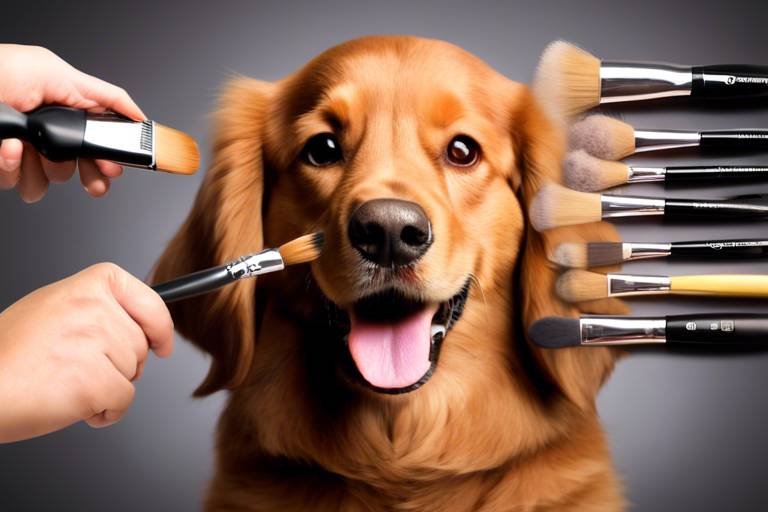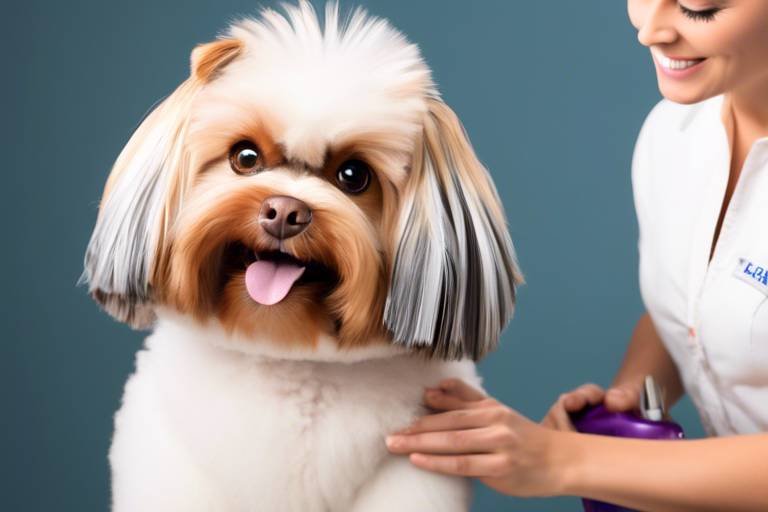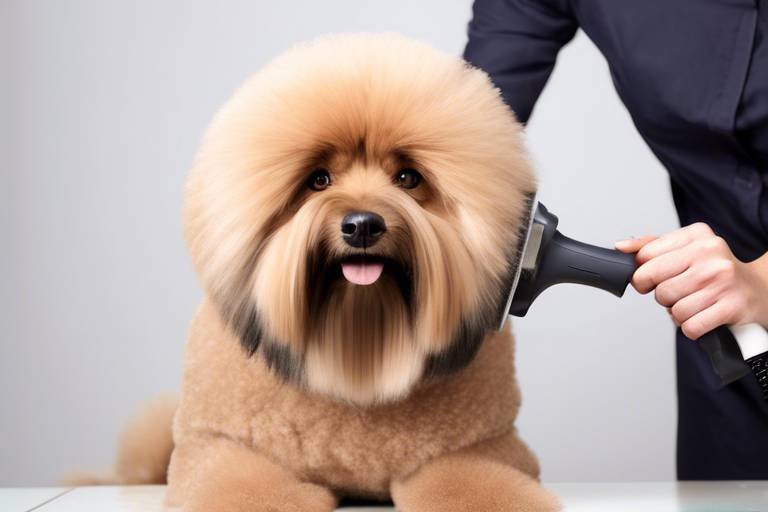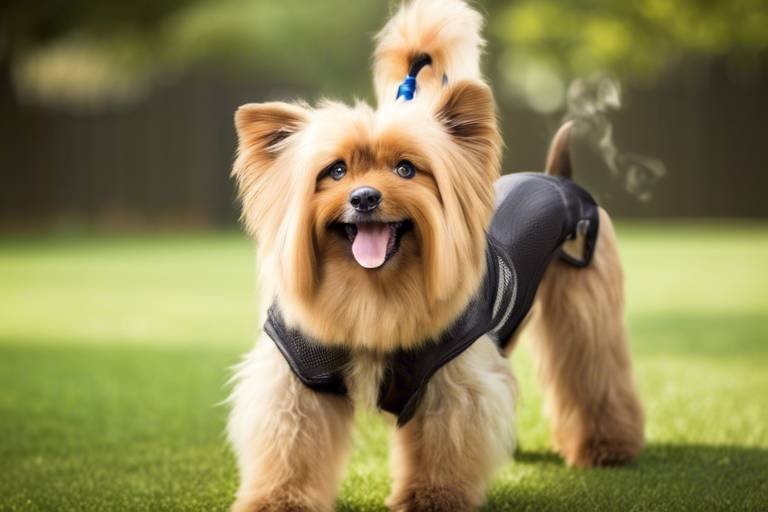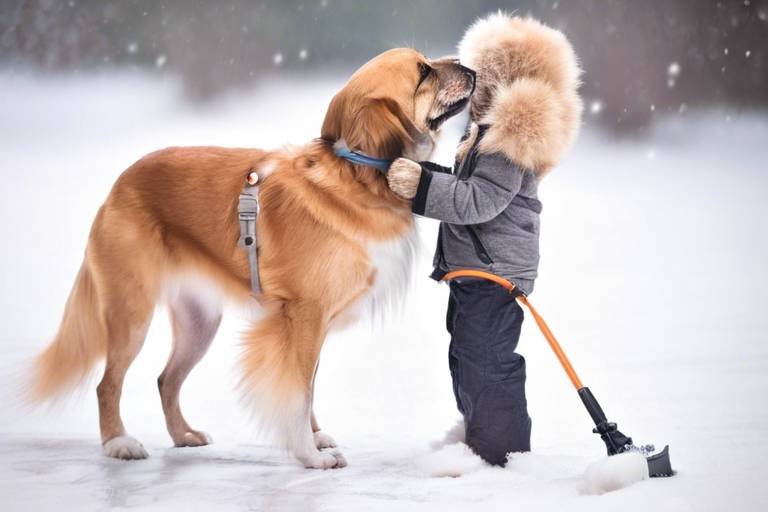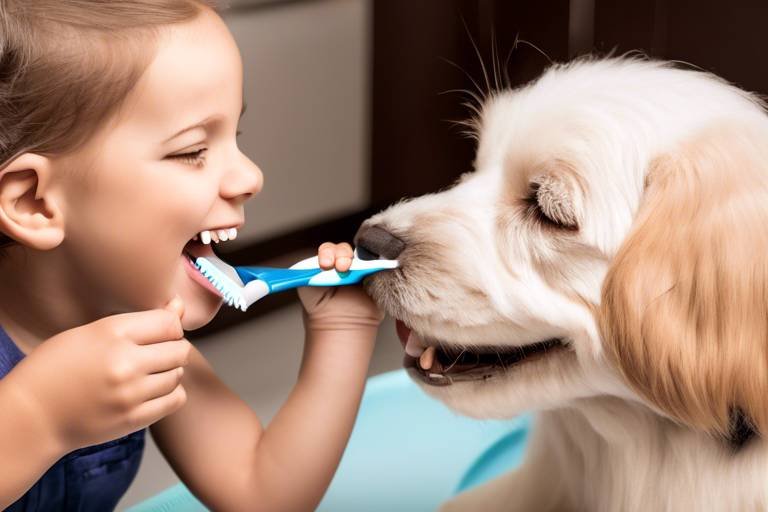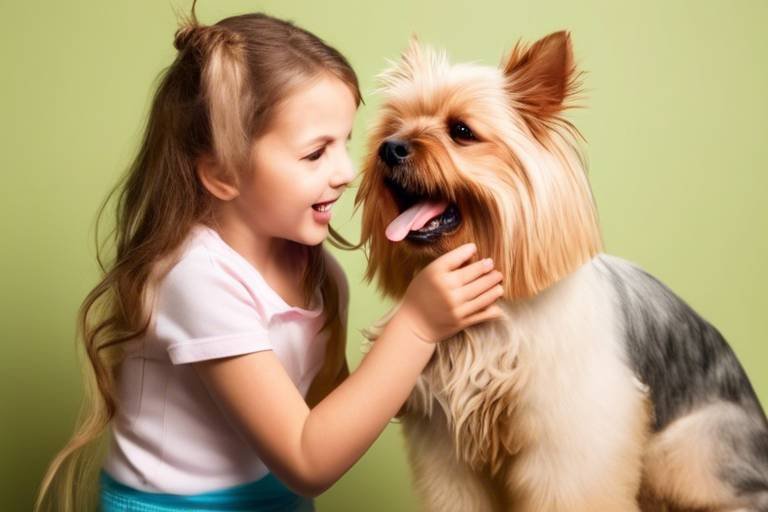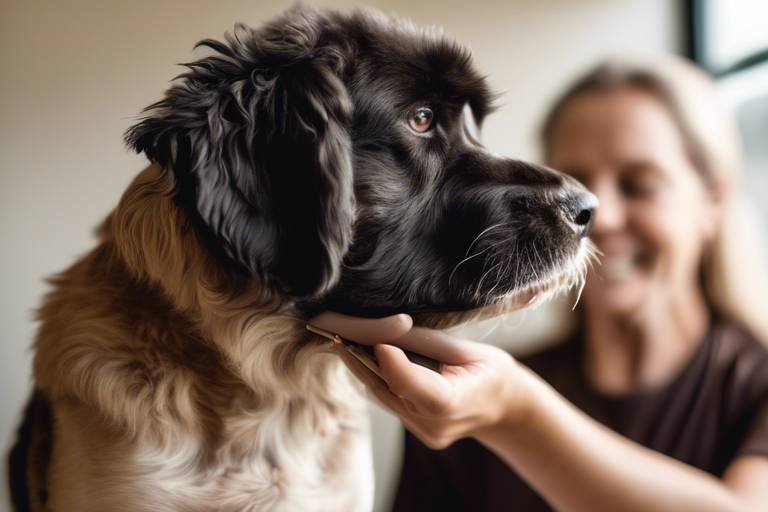How to Choose the Right Brush for Your Pet
Choosing the right brush for your beloved pet is not just a matter of aesthetics; it's a crucial part of their overall health and well-being. Imagine this: every time you groom your furry friend, you're not only making them look fabulous but also helping to promote healthy skin and reduce shedding around your home. A good grooming session can be a bonding experience, turning what may seem like a chore into a delightful ritual. But how do you pick the perfect brush? This guide will walk you through the essentials, from understanding your pet's coat type to selecting the right tools for the job. Let's dive in!
Before you even think about picking a brush, you need to understand your pet's unique coat type. Just like humans have different hair textures, pets have a variety of fur styles that require specific grooming tools. Is your pet's fur short, long, curly, or wiry? Each type has its own grooming needs. For example, long-haired breeds like the Maine Coon or the Shih Tzu need brushes that can tackle tangles and mats, while short-haired breeds like Beagles or Boxers may only need a simple bristle brush to keep their coat shiny and healthy. Knowing your pet's coat type is the first step in choosing the right brush!
Once you know your pet's coat type, it's time to explore the various brushes available on the market. Each brush is designed with specific features to cater to different grooming needs. Familiarizing yourself with these options can help you make an informed decision. Here are some common types of brushes:
Slicker brushes are a favorite among pet owners, especially for those with long-haired breeds. These brushes have fine, short wires that are closely spaced together, making them incredibly effective at removing mats and tangles without damaging the coat. They can reach deep into the fur, pulling out dead hair and dirt that might otherwise go unnoticed.
Using a slicker brush on your pet can yield numerous benefits:
- Removes Dead Hair: Regular use helps to keep your pet's coat clean and free from dead hair.
- Promotes Healthy Skin: By removing dirt and debris, slicker brushes help maintain healthy skin.
- Reduces Shedding: A slicker brush can significantly decrease the amount of fur you find around your home.
To get the most out of a slicker brush, start by dividing your pet's coat into sections. Gently work through each section, beginning at the base and moving toward the tips. Always be cautious around sensitive areas like the belly and underarms to avoid causing discomfort. With a little patience, your pet will begin to associate grooming with love and care!
If your pet has short hair, a bristle brush might be the perfect choice. These brushes are gentle on the skin and work wonders at distributing natural oils throughout the coat, enhancing its shine. Regular use can lead to a softer, healthier coat that your pet will love!
Size matters when it comes to choosing a brush. A brush that fits comfortably in your hand and is appropriate for your pet's size will make grooming much more enjoyable for both of you. For small pets, look for lightweight brushes that are easy to maneuver. This ensures you can reach all areas of their coat without causing stress. On the other hand, larger pets need sturdy, ergonomic brushes that can handle their thicker fur without straining your wrist.
When grooming small pets, it's essential to choose a brush that is not only lightweight but also designed for their delicate coats. A small, soft-bristled brush can make all the difference in keeping your little friend comfortable and happy during grooming sessions.
Larger breeds require brushes that are built to handle their size and fur density. Opt for brushes with a comfortable grip and sturdy bristles to ensure effective grooming without causing fatigue. The right brush can make the grooming experience enjoyable for both you and your large canine companion!
How often should you groom your pet? This question varies depending on their coat type, shedding patterns, and lifestyle. Establishing a regular grooming schedule is essential for maintaining your pet's coat health. Some pets, particularly those with long or thick coats, may benefit from daily grooming, while others may only need a good brush once a week. Pay attention to your pet's needs and adjust your grooming routine accordingly.
Assess your pet's grooming needs based on their coat type. For instance, long-haired breeds may require daily grooming to prevent mats, while short-haired breeds might only need a quick brush once a week. Tailoring your grooming schedule to your pet's specific needs will help keep their coat looking its best!
Keep an eye out for signs that indicate your pet may need a grooming session. Look for excessive shedding, tangles, or a dull coat. If your pet starts showing these signs, it may be time to adjust your grooming frequency or consider investing in a different brush to better suit their needs.
1. How often should I groom my pet?
This depends on your pet's coat type. Long-haired pets may need daily grooming, while short-haired pets might only require weekly sessions.
2. What type of brush is best for my pet?
The best brush for your pet depends on their coat type. Slicker brushes work well for long-haired pets, while bristle brushes are ideal for short-haired ones.
3. Can I use human brushes on my pet?
It's not recommended. Pet brushes are specifically designed for their fur types and skin sensitivities.
4. How can I make grooming more enjoyable for my pet?
Make grooming a positive experience by using treats and praise, and by keeping sessions short and gentle.
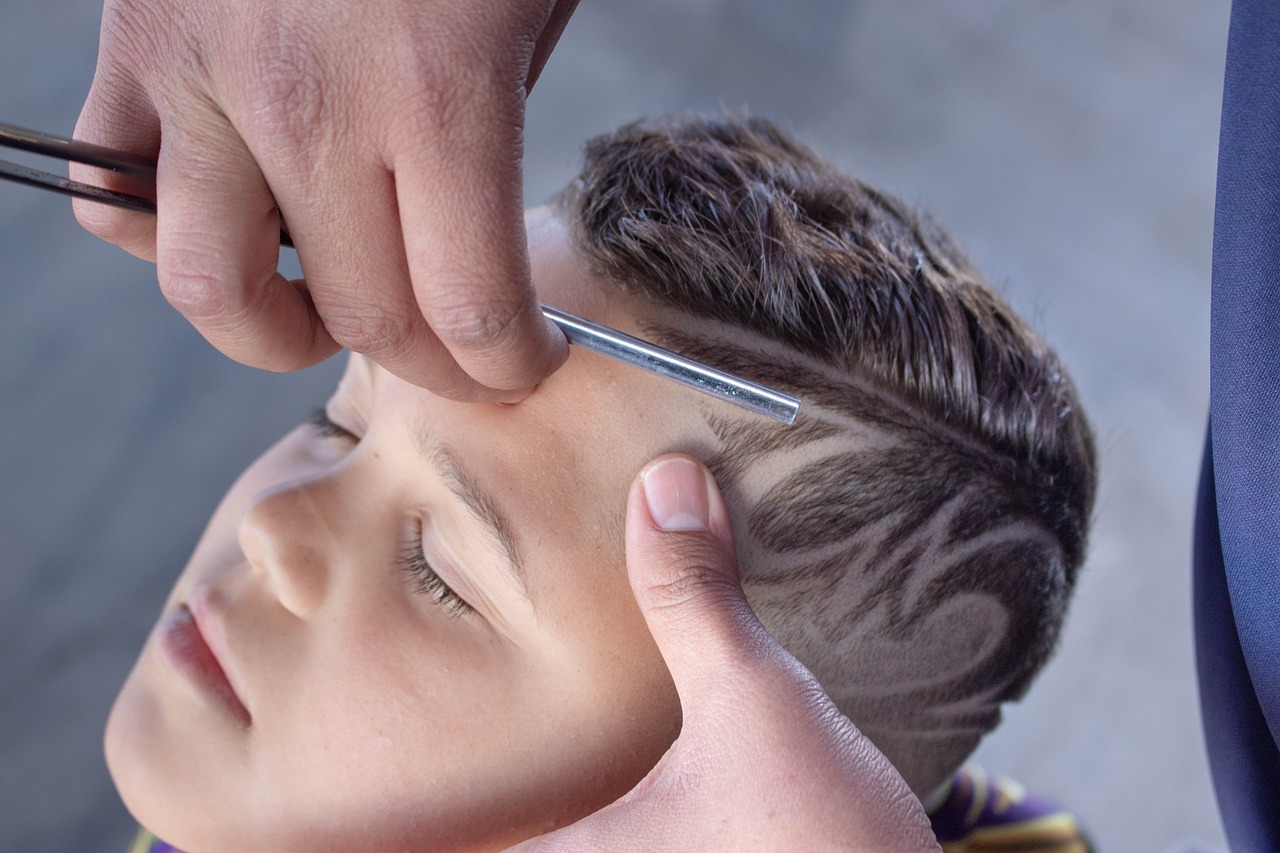
Understanding Your Pet's Coat Type
When it comes to grooming your furry friend, understanding their coat type is absolutely essential. Just like humans have different hair textures and styles, pets have unique fur types that significantly influence the grooming tools and techniques you should use. Imagine trying to comb through a thick, curly mane with a fine-toothed comb—frustrating, right? The same logic applies to your pet's coat. By identifying whether your pet has a short, long, curly, or wiry coat, you can select the right brush and make grooming a more pleasant experience for both of you.
Let’s break it down a bit further. Here’s a quick overview of common coat types:
- Short Coats: These coats are sleek and require minimal grooming. Breeds like Beagles and Boxers fall into this category. A simple bristle brush or a rubber grooming mitt is often sufficient.
- Long Coats: Think of breeds like Golden Retrievers or Persian Cats. Their luxurious fur can easily become tangled, so investing in a slicker brush is a wise choice to prevent mats and keep their coat shiny.
- Curly Coats: Breeds such as Poodles and Portuguese Water Dogs have curly fur that can trap dirt and debris. A pin brush or a slicker brush can help maintain their coat's health and appearance.
- Wiry Coats: Breeds like Wire Fox Terriers and Scottish Terriers have coarse, wiry hair that requires special attention. A bristle brush or a stripping knife can help keep their coat looking its best.
Understanding your pet's coat type not only helps in choosing the right brush but also allows you to tailor your grooming routine to their specific needs. For instance, long-haired pets may require more frequent grooming sessions to prevent tangles, while short-haired pets might only need a quick brush once a week. In addition to the coat type, consider your pet’s lifestyle; active pets may need more grooming due to dirt and debris accumulation. By taking these factors into account, you can create a grooming plan that promotes a healthy, happy coat.
Ultimately, the right brush can make a world of difference. Just like a good haircut can boost your confidence, a well-groomed pet not only looks great but feels great too. So, take the time to understand your pet's coat type, and you'll be well on your way to a successful grooming routine.
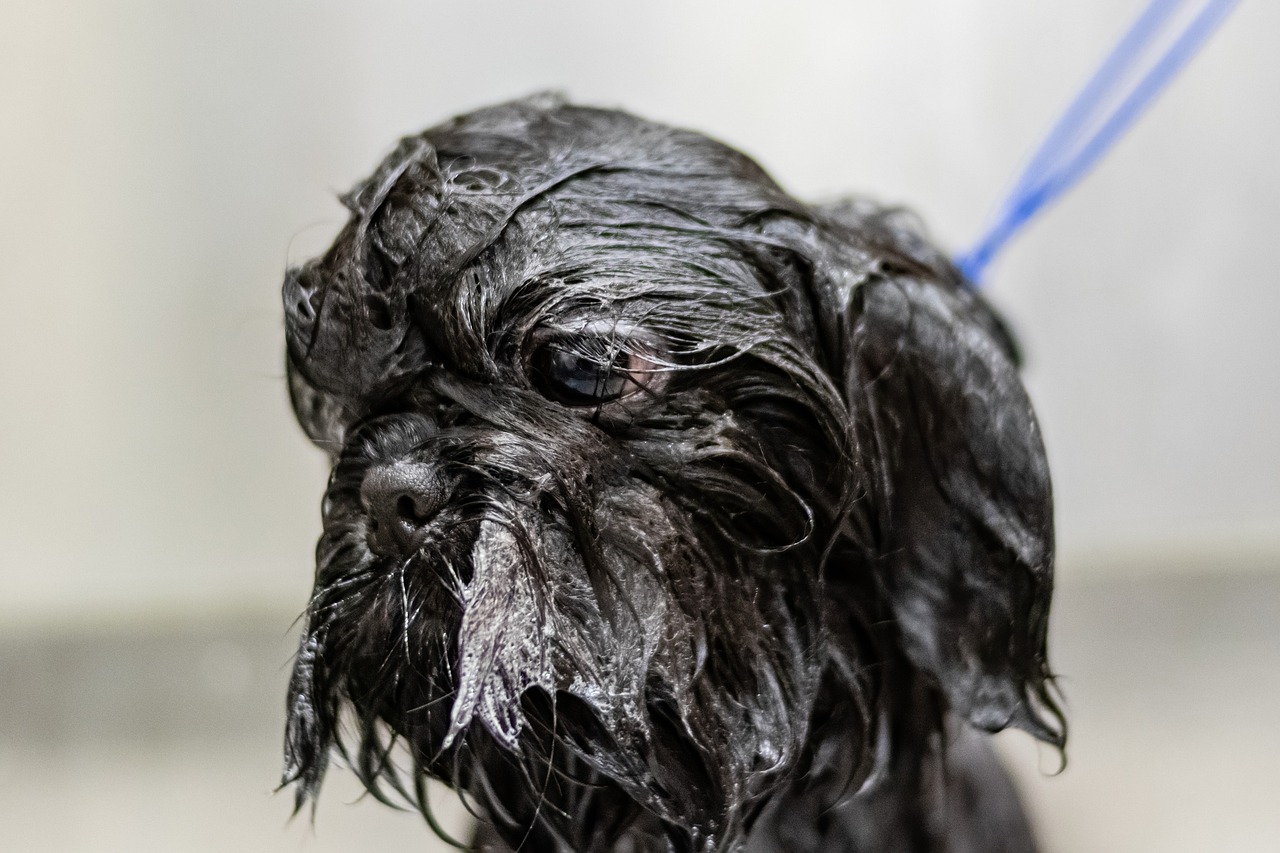
Types of Brushes Available
When it comes to grooming your pet, understanding the different types of brushes available is crucial for maintaining their coat and skin health. Each brush is designed with specific features that cater to various coat types and grooming needs. By familiarizing yourself with these options, you can make an informed decision that will not only enhance your pet's grooming experience but also promote their overall well-being.
First up, we have the slicker brush. This brush is a favorite among pet owners with long-haired breeds. Its fine, short wires are closely spaced, making it incredibly effective at removing mats and tangles without damaging the coat. Slicker brushes are excellent for getting rid of dead hair and dirt, resulting in a healthier and shinier appearance for your furry friend. Regular use can significantly reduce shedding around your home, which is a win-win for both you and your pet.
Next, let’s talk about bristle brushes. These brushes are typically used for short-haired pets, and they excel at distributing natural oils throughout the coat. The bristles are gentle on the skin, making them perfect for pets that may be sensitive to harsher grooming tools. With regular use, bristle brushes can enhance your pet's coat shine, giving them that extra glow that turns heads at the dog park.
For those pets that have a thick undercoat, you might want to consider a de-shedding tool. These brushes are specifically designed to reach beneath the top coat and remove loose undercoat hair. They can be a game changer for breeds that shed heavily, as they help to manage shedding and keep your home cleaner. It’s like having a mini grooming salon right at home!
Another option is the rubber brush. These brushes are particularly effective for pets who enjoy a good massage while being groomed. The rubber bristles stimulate the skin and can help to remove loose hair while being gentle enough not to irritate. It’s a great choice for pets that may be anxious during grooming sessions, as the rubber bristles provide a soothing effect.
Lastly, there are comb brushes, which are perfect for detangling and finishing touches. These brushes can be used after the initial grooming with a slicker or bristle brush to ensure that your pet’s coat is completely tangle-free. They are particularly useful for pets with long, flowing coats that tend to get knotted easily.
In summary, the right brush can make a world of difference in your pet's grooming routine. Whether you opt for a slicker brush, bristle brush, de-shedding tool, rubber brush, or comb brush, understanding your pet’s specific needs will guide you to the best choice. Remember, grooming is not just about aesthetics; it’s about ensuring your pet feels comfortable and loved!
- How often should I groom my pet? - This depends on your pet's coat type. Long-haired breeds may require daily grooming, while short-haired breeds can be groomed weekly.
- Can I use human brushes on my pet? - It's best to use brushes specifically designed for pets, as human brushes may not be suitable for their coat types.
- What should I do if my pet dislikes brushing? - Start with short sessions and use treats to create a positive association with grooming.
- How do I clean my brushes? - Regularly remove hair from the brush and wash it with mild soap and water to keep it hygienic.
Slicker Brushes
Slicker brushes are a grooming essential for pet owners, especially those with long-haired or curly coats. These brushes are designed to tackle the toughest tangles and mats, making them a favorite among groomers and pet lovers alike. The unique design features fine, short wires that are closely spaced together, allowing them to penetrate deep into the fur without damaging the coat. Imagine trying to untangle a necklace; a slicker brush works similarly, carefully working through the knots to restore order and beauty to your pet's fur.
One of the standout benefits of using a slicker brush is its ability to remove dead hair and dirt effectively. Regular grooming sessions not only keep your pet looking their best but also promote a healthier and shinier coat. This is particularly important for pets that shed frequently, as it helps to minimize the amount of fur left around your home. Think of it as a mini spa day for your furry friend—who doesn’t love a good pampering session?
To get the most out of your slicker brush, it’s crucial to use it correctly. Begin by dividing your pet's coat into manageable sections. Start at the base of the fur and gently brush towards the tips, being careful around sensitive areas like the belly and behind the ears. If you encounter any tangles, avoid yanking; instead, work them out slowly to prevent discomfort. With a little patience and practice, grooming can become a bonding experience between you and your pet.
Here’s a quick overview of the benefits of slicker brushes:
| Benefit | Description |
|---|---|
| Removes Mats | Effectively tackles tangles and mats in long fur. |
| Promotes Healthy Skin | Removes dead hair and dirt, allowing skin to breathe. |
| Reduces Shedding | Regular use minimizes shedding around the house. |
| Enhances Coat Shine | Regular brushing distributes natural oils for a shiny coat. |
In conclusion, slicker brushes are a fantastic tool for maintaining your pet's grooming routine. They not only simplify the process of keeping your pet's coat neat and tidy but also contribute to their overall health and happiness. So, the next time you're gearing up for a grooming session, remember the slicker brush—it just might become your new best friend!
- How often should I use a slicker brush on my pet? It depends on your pet's coat type. Long-haired breeds may benefit from daily brushing, while short-haired ones might only need it weekly.
- Can I use a slicker brush on my cat? Yes! Slicker brushes can be used on cats, especially those with longer fur, to help reduce mats and shedding.
- Is it safe to use a slicker brush on sensitive areas? Yes, but be gentle! Always use a soft hand around sensitive spots to avoid causing discomfort.
Benefits of Slicker Brushes
Selecting the appropriate brush for your pet can enhance their grooming experience, promote healthy skin, and reduce shedding. This guide explores various brush types, their benefits, and tips for choosing the best one.
Different pets have unique coat types, which influence the grooming tools needed. Learning about your pet's fur—whether it's short, long, curly, or wiry—helps in selecting the right brush for effective grooming.
There are various brushes designed for different coat types and grooming needs. Familiarizing yourself with these options can help you make an informed decision when selecting the best brush for your pet.
Slicker brushes are ideal for removing mats and tangles, especially in long-haired breeds. They feature fine, short wires close together, making them effective for thorough grooming without damaging the coat.
Using a slicker brush can significantly enhance your pet's grooming routine. Here are some of the key benefits:
- Effective Mat Removal: Slicker brushes excel at tackling mats and tangles, making them essential for pets with longer or thicker fur.
- Promotes Healthy Skin: Regular brushing with a slicker brush helps remove dead hair and dirt, which can lead to healthier skin and a shinier coat.
- Reduces Shedding: By removing loose fur during grooming sessions, slicker brushes can help minimize shedding around your home, keeping your living space cleaner.
- Enhances Bonding: Grooming your pet can strengthen your bond. The gentle strokes of a slicker brush can be a soothing experience for your furry friend.
Moreover, slicker brushes are designed to be gentle on your pet's skin while providing a thorough clean. This means that you can brush with confidence, knowing that you are not causing discomfort. When used regularly, slicker brushes can help maintain a beautiful, healthy coat that turns heads wherever you go!
To effectively use a slicker brush, gently work through your pet's coat in sections, starting from the base and moving to the tips. Be cautious around sensitive areas to avoid discomfort.
Bristle brushes are perfect for short-haired pets and help distribute natural oils throughout the coat. They are gentle on the skin and can enhance your pet's coat shine with regular use.
Selecting the appropriate size brush is crucial for effective grooming. A brush that fits comfortably in your hand and suits your pet's size will make the grooming process more efficient and enjoyable.
For small pets, choose a brush that is lightweight and easy to maneuver. This ensures you can reach all areas of their coat without causing stress or discomfort during the grooming session.
Larger pets require brushes that can handle their thicker fur and larger body size. Opt for sturdy, ergonomic brushes that allow you to groom effectively without straining your hand or wrist.
Understanding how often to groom your pet is essential for maintaining their coat health. Regular grooming schedules can vary based on coat type, shedding patterns, and your pet's lifestyle.
Some pets benefit from daily grooming, particularly those with long or thick coats, while others may only need weekly sessions. Assess your pet's needs to create a suitable grooming routine.
Look for signs such as excessive shedding, tangles, or a dull coat. If your pet exhibits these signs, it may be time to adjust your grooming frequency or consider a different brush.
Q: How often should I brush my pet?
A: The frequency of brushing depends on your pet's coat type. Long-haired pets may need daily brushing, while short-haired pets might only require weekly grooming.
Q: Can I use a slicker brush on all coat types?
A: Slicker brushes are best suited for long-haired and curly coats. For short-haired pets, a bristle brush may be more appropriate.
Q: What should I do if my pet resists grooming?
A: Start slowly and make grooming a positive experience with treats and praise. Gradually increase the duration of grooming sessions to help your pet get used to it.
How to Use Slicker Brushes
Using a slicker brush can be a game-changer for your pet's grooming routine, especially if they have a long or dense coat. To get the best results, it’s important to approach the grooming process with care and technique. Start by ensuring your pet is comfortable and relaxed. You might want to choose a quiet space where they feel at ease, perhaps with their favorite toys nearby. This will help create a positive grooming experience.
Begin by dividing your pet's coat into manageable sections. This is crucial because working in sections allows you to focus on tangles and mats without overwhelming either you or your pet. Start at the base of the coat, near the skin, and gently work your way to the tips. It's important to use a gentle touch; applying too much pressure can cause discomfort. As you brush, you might find it helpful to use a technique similar to painting—long, smooth strokes will help you cover more area and ensure an even grooming session.
While brushing, keep an eye out for any knots or tangles. If you encounter a particularly stubborn mat, gently hold the hair above it to avoid pulling on the skin. You can use the slicker brush to work through the mat slowly. Remember, patience is key! If the mat is too tight, consider using your fingers to gently separate the hair or invest in a dematting tool for a more effective solution.
Don’t forget the sensitive areas, such as behind the ears, under the legs, and around the tail. These spots can be prone to tangling, so approach them with extra caution. It's advisable to brush these areas gently and perhaps even switch to a softer brush if your pet seems uncomfortable.
After you finish brushing, it's a great idea to reward your pet with a treat or some playtime. This helps them associate grooming with positive experiences, making future grooming sessions easier. Regular use of a slicker brush not only keeps your pet looking fabulous but also promotes a healthier coat by reducing shedding and distributing natural oils. So grab that brush and make grooming a fun and enjoyable part of your pet care routine!
- How often should I use a slicker brush on my pet? It depends on your pet's coat type. Long-haired pets may benefit from daily brushing, while short-haired pets might only need it once a week.
- Can I use a slicker brush on my cat? Yes! Slicker brushes are effective for both dogs and cats, particularly those with longer fur.
- What should I do if my pet doesn’t like being brushed? Start slowly, and ensure they are comfortable. You can also try to make it a positive experience with treats and praise.
- Are there any risks associated with using a slicker brush? If used improperly, slicker brushes can irritate the skin or cause discomfort. Always be gentle and watch for signs of distress in your pet.
Bristle Brushes
Bristle brushes are a fantastic grooming tool, especially for pets with short hair. They are designed with soft, flexible bristles that glide smoothly over your pet's coat, making the grooming experience not only effective but also enjoyable for your furry friend. Think of a bristle brush as a gentle massage for your pet—it's like a spa day that helps distribute natural oils throughout their fur, ensuring it maintains a healthy shine.
One of the main advantages of using a bristle brush is its ability to enhance your pet's coat appearance. Regular brushing with this type of brush can significantly reduce the appearance of dullness, giving your pet that vibrant, glossy look we all love to see. Moreover, the soft bristles are gentle on the skin, making it a perfect choice for pets that may be sensitive or easily irritated. It's like finding the perfect pillow—soft enough to be comfortable but firm enough to provide support.
When using a bristle brush, it’s essential to follow a few simple steps to maximize its benefits:
- Start Slowly: Introduce the brush to your pet gradually. Let them sniff it and get comfortable before you start grooming.
- Brush in the Direction of Hair Growth: Always brush in the direction that the hair grows to avoid pulling and discomfort.
- Be Gentle: Use light pressure to avoid irritating your pet's skin, especially if they have sensitive areas.
Another noteworthy aspect of bristle brushes is their versatility. They can be used on various coat types, although they are particularly effective for short-haired breeds. If you have a mixed-breed pet, a bristle brush can still be a valuable addition to your grooming toolkit. Just remember, while they are great for smoothing and shining, they may not be as effective for detangling or removing mats compared to slicker brushes.
In summary, bristle brushes are an excellent option for pet owners looking to keep their short-haired companions looking their best. They provide a gentle yet effective grooming experience that promotes healthy skin and a shiny coat. So, if you want to pamper your pet while ensuring they look fabulous, a bristle brush might just be the perfect tool for you!
Q: How often should I use a bristle brush on my pet?
A: For short-haired pets, brushing once a week is typically sufficient. However, if your pet enjoys the grooming process, feel free to brush them more often!
Q: Can I use a bristle brush on a long-haired pet?
A: While bristle brushes can be used on long-haired pets, they may not be as effective for detangling. It's best to use a slicker brush for long-haired breeds and follow up with a bristle brush for added shine.
Q: What should I do if my pet doesn't like being brushed?
A: Start with short sessions and reward your pet with treats and praise. Gradually increase the time as they become more comfortable with the process.
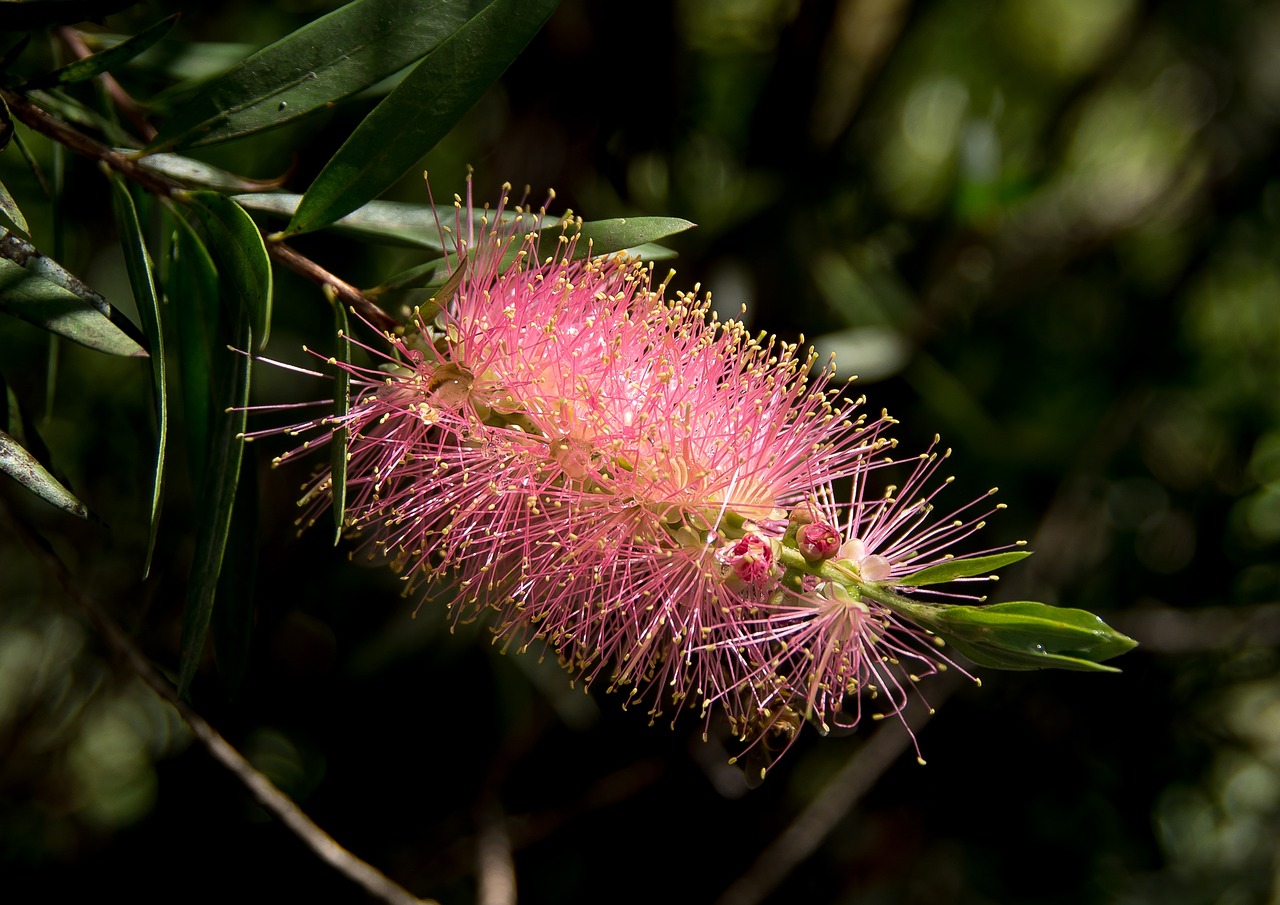
Choosing the Right Size Brush
When it comes to grooming your furry friend, selecting the right size brush is absolutely crucial. Imagine trying to comb your hair with a tiny brush—it just wouldn’t work, right? Similarly, using a brush that doesn’t fit your pet’s size can lead to ineffective grooming and even discomfort. A well-sized brush not only makes the grooming process easier for you but also more enjoyable for your pet.
First, consider the size of your pet. If you have a small dog or cat, a lightweight and compact brush is ideal. This allows you to maneuver around their delicate areas without causing any stress. On the other hand, larger breeds require brushes that can handle their thicker fur and larger body size. Think of it like using a shovel for a big pile of dirt; you want something that can manage the job efficiently!
Here’s a quick breakdown of what to look for based on your pet’s size:
| Pet Size | Recommended Brush Type |
|---|---|
| Small Pets (e.g., Chihuahuas, Cats) | Lightweight, small brushes (e.g., bristle brushes) |
| Medium Pets (e.g., Beagles, Cocker Spaniels) | Medium-sized brushes (e.g., slicker brushes) |
| Large Pets (e.g., Golden Retrievers, German Shepherds) | Sturdy, ergonomic brushes (e.g., de-shedding tools) |
Additionally, the ergonomics of the brush handle play a significant role in your grooming experience. A brush that fits comfortably in your hand can reduce fatigue during longer grooming sessions. You wouldn’t want to tire out your hand while trying to keep your pet looking fabulous, would you?
Another aspect to consider is the length of your pet’s coat. Longer-haired pets may benefit from brushes with wider bristles or those designed to reach deeper into the coat, while short-haired pets might only need a simple bristle brush to keep their coat shiny and healthy. Think of it like using different tools for different tasks in your toolbox; each brush serves a specific purpose based on your pet’s grooming needs.
Ultimately, choosing the right size brush is about understanding your pet's unique requirements. By investing time in selecting the appropriate brush, you’re not just enhancing their grooming experience; you’re also promoting their overall well-being. Remember, a happy pet is a well-groomed pet!
Considerations for Small Pets
When it comes to grooming small pets, there are several important factors to keep in mind. These adorable little companions, whether they are hamsters, guinea pigs, or small dog breeds, often require special attention during grooming sessions. First and foremost, the size of the brush is crucial. A brush that is too large can be cumbersome and may cause discomfort to your furry friend. Instead, opt for a brush that fits comfortably in your hand and is specifically designed for small pets. This will allow you to maneuver easily and reach all areas of their coat without causing undue stress.
Another consideration is the gentleness of the brush bristles. Small pets typically have sensitive skin, so using a brush with soft bristles is essential. For instance, a bristle brush with rounded tips can be an excellent choice, as it distributes natural oils while being gentle on the skin. Moreover, the frequency of grooming plays a significant role in maintaining your pet’s coat health. Small pets, depending on their coat type, may require more frequent grooming sessions to prevent matting and to keep their fur looking its best. Regular grooming not only helps keep their coat clean but also provides an opportunity for bonding.
To make grooming even more enjoyable for your small pet, consider creating a calm environment. You can do this by choosing a quiet space, free from distractions, and using treats to reward your pet during the grooming process. This positive reinforcement helps them associate grooming with a pleasant experience. If your small pet shows signs of anxiety, take breaks as needed to ensure they remain comfortable throughout the session.
In summary, grooming small pets requires a thoughtful approach. By selecting the right brush size, ensuring gentleness, maintaining a regular grooming schedule, and creating a soothing environment, you can enhance your pet's grooming experience significantly. Remember, grooming is not just about aesthetics; it’s about the overall health and happiness of your beloved companion.
- How often should I groom my small pet? The frequency of grooming depends on your pet's coat type. Generally, short-haired pets may require grooming once a week, while long-haired pets might need daily sessions.
- What type of brush is best for my small pet? The best type of brush varies by species. For example, small dogs may benefit from a bristle brush, while guinea pigs might require a slicker brush for their longer fur.
- Can I use human brushes on my small pet? It's not recommended to use human brushes, as they are often too harsh for small pets' sensitive skin. Always choose brushes specifically designed for animals.
- How can I make grooming less stressful for my pet? Create a calm environment, use treats for positive reinforcement, and take breaks if your pet appears anxious to ensure a more enjoyable grooming experience.
Brushes for Large Breeds
When it comes to grooming large breeds, the right brush can make all the difference. These pets often have thicker, denser fur that requires specialized tools to ensure effective grooming. A sturdy, ergonomic brush is essential, as it allows you to manage their larger body size without straining your hand or wrist. Think of it like using a shovel for a big job; the right tool not only makes the task easier but also ensures that you do it well.
For large breeds, consider brushes that are designed specifically to handle their unique coat types. Here are some of the best options:
- Undercoat Rakes: Perfect for breeds with a thick undercoat, these rakes help remove loose fur and prevent matting.
- Pin Brushes: With rounded tips, these brushes are great for detangling and smoothing out long fur without causing discomfort.
- De-shedding Tools: If your large breed sheds heavily, a de-shedding tool can be a game changer. These are designed to reach deep into the coat and remove loose hair effectively.
Choosing a brush that is both effective and comfortable for you and your pet is crucial. Look for features such as a non-slip handle, which provides a better grip during grooming sessions. Additionally, consider the brush head size; a larger head can cover more area quickly, making the grooming process more efficient. Just like a painter prefers a larger brush for a big canvas, you’ll want a tool that helps you tackle your pet’s coat with ease.
Lastly, remember that grooming should always be a positive experience for your pet. Take breaks if needed and reward them with treats or affection to create a bond during grooming sessions. After all, a happy pet is a well-groomed pet!
Q1: How often should I groom my large breed dog?
A1: The frequency of grooming depends on your dog's coat type. Generally, large breeds with long or thick coats may require grooming 2-3 times a week, while those with shorter coats might only need it weekly.
Q2: What type of brush is best for my large breed?
A2: The best brush depends on your dog's coat type. For thick or double coats, undercoat rakes and de-shedding tools are ideal. For long-haired breeds, pin brushes work well.
Q3: Can I use the same brush for different pets?
A3: While it is possible, it’s best to use brushes tailored to each pet's coat type to ensure effective grooming and prevent any skin irritation.
Q4: How can I make grooming enjoyable for my dog?
A4: Create a calm environment, use positive reinforcement, and take breaks during grooming sessions. Offering treats and praise can help your dog associate grooming with a positive experience.
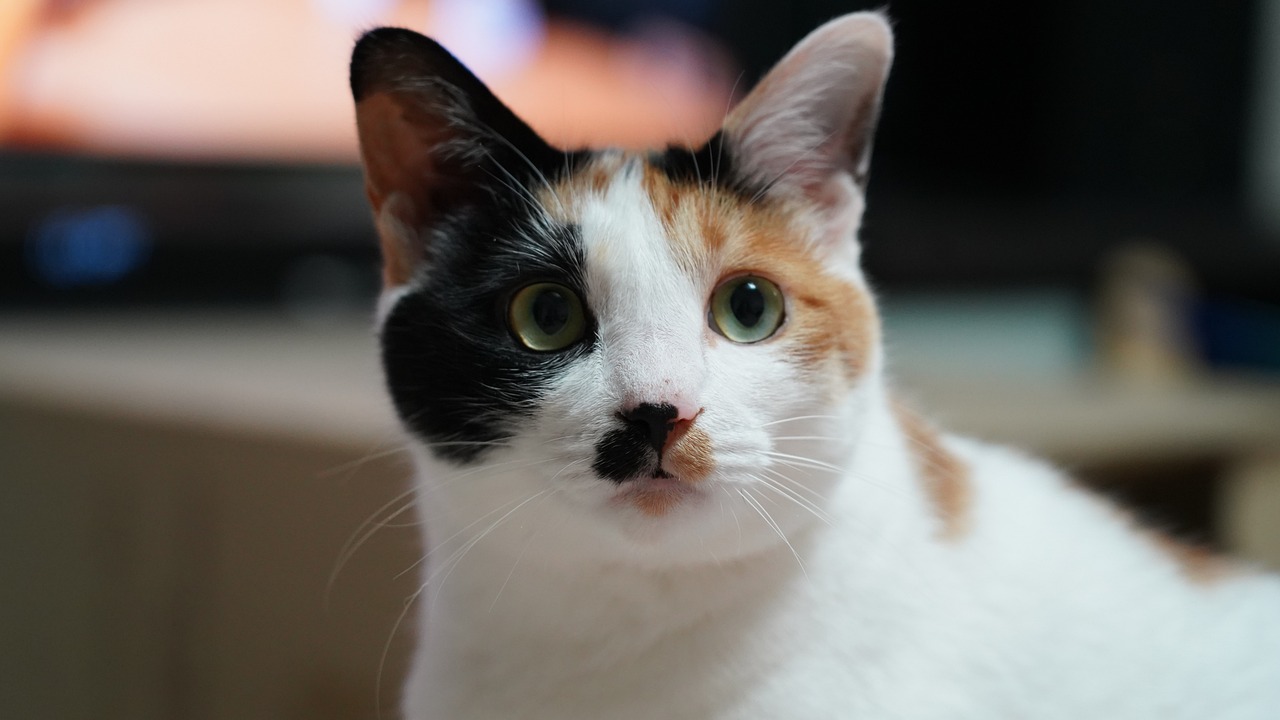
Frequency of Grooming
Understanding how often to groom your pet is essential for maintaining their coat health and overall well-being. Just like how we need regular haircuts to keep our locks looking fabulous, pets also thrive on a consistent grooming schedule. However, the frequency of grooming can vary significantly based on several factors, including your pet's coat type, shedding patterns, and their lifestyle. For instance, a fluffy golden retriever might require more frequent grooming than a sleek short-haired dachshund. So, how do you determine the right grooming schedule for your furry friend?
Generally speaking, pets with long or thick coats tend to benefit from daily grooming. This not only helps to remove tangles and mats but also distributes natural oils throughout their fur, promoting a healthy shine. On the other hand, pets with shorter coats may only need grooming sessions on a weekly basis. It’s also important to consider your pet’s activity level; a more active pet might get dirtier faster, necessitating more frequent grooming. To simplify this, here’s a quick breakdown:
| Coat Type | Recommended Grooming Frequency |
|---|---|
| Long-haired | Daily |
| Medium-haired | 2-3 times a week |
| Short-haired | Weekly |
Another key aspect of grooming frequency is being observant of your pet's coat condition. Look out for signs that indicate a grooming session is overdue. For example, excessive shedding, noticeable tangles, or a dull-looking coat are all red flags that your pet might need some extra TLC. If you notice your pet scratching more than usual or if their coat feels rough to the touch, it might be time to step up your grooming game. Adjusting your grooming frequency can help keep your pet comfortable and looking their best.
Ultimately, the goal is to create a grooming routine that works for both you and your pet. Regular grooming not only enhances your pet’s appearance but also strengthens the bond between you two. Think of it as a special time to connect, similar to how we enjoy a spa day. So grab that brush, put on some calming music, and make grooming a fun and rewarding experience for both of you!
- How often should I groom my pet? The frequency depends on your pet's coat type. Long-haired pets may need daily grooming, while short-haired ones might only require weekly sessions.
- What signs indicate my pet needs grooming? Look for excessive shedding, tangles, or a dull coat. If your pet seems uncomfortable or is scratching more, it might be time for a grooming session.
- Can I groom my pet too much? Yes, over-grooming can irritate your pet’s skin. It's essential to find a balance that keeps their coat healthy without causing discomfort.
Daily vs. Weekly Grooming
When it comes to grooming your pet, the frequency can make a world of difference, both for their coat and your home. You might be wondering, "How often should I brush my furry friend?" Well, the answer isn't one-size-fits-all; it largely depends on your pet's coat type, shedding patterns, and lifestyle. For instance, pets with long or thick coats often require daily grooming to prevent mats and tangles. Imagine trying to comb through a tangled ball of yarn; the longer you wait, the harder it becomes! Daily brushing not only keeps their coat looking fabulous but also reduces the amount of fur you find on your furniture and clothes.
On the other hand, pets with shorter coats might only need grooming once a week. This can be sufficient to remove loose hair and distribute natural oils throughout the coat. Think of it like a quick tidy-up instead of a full spring cleaning. However, if you notice your pet shedding more than usual or their coat looking lackluster, it might be time to increase the frequency of grooming sessions.
Here’s a quick comparison to help you decide:
| Coat Type | Recommended Grooming Frequency | Benefits |
|---|---|---|
| Long-haired | Daily | Prevents mats, reduces shedding, promotes shine |
| Short-haired | Weekly | Removes loose hair, distributes oils |
| Curly or wiry | Every few days | Prevents tangles, maintains texture |
Ultimately, the key is to observe your pet. If they seem uncomfortable or if their coat looks unkempt, it might be time to adjust your grooming schedule. Regular grooming sessions not only keep your pet looking their best, but they also provide a wonderful opportunity for bonding. So grab that brush and make it a fun routine!
- How often should I groom my pet? It depends on their coat type. Long-haired pets usually need daily grooming, while short-haired ones may only require weekly sessions.
- What happens if I don’t groom my pet regularly? Neglecting grooming can lead to mats, tangles, and skin issues, and you may find more fur around your home.
- Can I use human brushes on my pet? It’s best to use brushes specifically designed for pets to avoid damaging their coat and skin.
Signs Your Pet Needs Grooming
Grooming your pet isn't just about keeping them looking fabulous; it's crucial for their overall health and well-being. But how do you know when it's time to pick up that brush? There are several tell-tale signs that indicate your furry friend might be in need of a grooming session. First and foremost, pay attention to excessive shedding. If you notice clumps of fur around your home or on your clothes, it's a clear signal that your pet's coat is due for some TLC. Regular grooming helps to remove dead hair and prevents it from accumulating in your living space.
Another important sign is the presence of tangles and mats. If you run your fingers through your pet's coat and encounter knots, it's time to get brushing. Mats can pull on the skin, leading to discomfort or even skin irritations. Long-haired breeds, in particular, are prone to these issues, so keeping an eye out for them is essential. Additionally, a dull or greasy coat can indicate that your pet is overdue for some grooming. A healthy coat should be shiny and vibrant, reflecting good skin health and proper grooming habits.
Moreover, if your pet seems to be scratching or biting at their fur more than usual, it might be a sign that they need grooming. This behavior can indicate skin irritations or discomfort caused by mats or dirt trapped in their coat. Regular brushing not only helps to keep their coat clean but also allows you to check for any skin issues that may need attention.
Lastly, consider your pet's grooming needs based on their lifestyle. Active pets that spend a lot of time outdoors may require more frequent grooming to remove dirt, debris, and loose fur. If you notice any of these signs, it’s wise to reassess your grooming routine and perhaps consider investing in a different type of brush that suits their coat type better.
- How often should I groom my pet? The frequency of grooming depends on your pet's coat type. Long-haired breeds may need daily grooming, while short-haired pets might only need it weekly.
- Can I use human brushes on my pet? It's best to use brushes specifically designed for pets, as they are tailored to their unique fur and skin needs.
- What should I do if my pet hates being groomed? Gradually acclimate your pet to the grooming process by using treats and positive reinforcement to make it a pleasant experience.
- Is it necessary to take my pet to a professional groomer? While many pets can be groomed at home, some may benefit from professional grooming, especially if they have complex coat types or require special care.
Frequently Asked Questions
- What type of brush should I use for my pet's coat?
The type of brush you should use depends on your pet's coat type. For long-haired pets, a slicker brush is ideal for removing mats and tangles. If your pet has a short coat, a bristle brush can help distribute natural oils and enhance shine. Always consider your pet's specific grooming needs when selecting a brush.
- How often should I groom my pet?
The grooming frequency varies based on your pet's coat type and shedding patterns. Long-haired pets may require daily grooming, while short-haired pets might only need weekly sessions. Regular grooming helps maintain coat health and prevents excessive shedding, so it's essential to create a routine that suits your pet.
- Can I use the same brush for different pets?
While you can use some brushes for different pets, it's best to choose brushes that cater specifically to each pet's coat type. For example, a slicker brush for a long-haired dog may not be suitable for a short-haired cat. Using the right brush ensures effective grooming and keeps your pets comfortable.
- What are the signs that my pet needs grooming?
Look for signs such as excessive shedding, tangles, or a dull coat. If your pet seems uncomfortable or is constantly itching, it might indicate that they need grooming. Regularly checking their coat will help you determine when it's time to groom them.
- How do I choose the right size brush for my pet?
Selecting the right size brush involves considering both your pet's size and the brush's handle. For smaller pets, a lightweight and easy-to-maneuver brush is essential, while larger breeds may need sturdier brushes that can handle thicker fur. Comfort and efficiency should be your top priorities.

